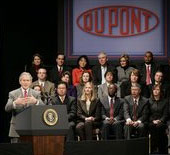 The goals set out by President Bush Tuesday night to increase alternative fuels nationwide were met with enthusiasm by the ethanol industry, but not so much by the livestock industry which is facing higher prices for feed and increased competition for grain crops.
The goals set out by President Bush Tuesday night to increase alternative fuels nationwide were met with enthusiasm by the ethanol industry, but not so much by the livestock industry which is facing higher prices for feed and increased competition for grain crops.
The president acknowledged those concerns during an appearance at a DuPont facility in Delaware. “There is a constraint, and that is the ethanol use today comes from corn, and we’ve got hog growers and chicken growers that need corn to feed their animals,” Bush said.
 Officials with the Renewable Fuels Association fielded questions about the issue during a telephone press conference with reporters Tuesday morning.
Officials with the Renewable Fuels Association fielded questions about the issue during a telephone press conference with reporters Tuesday morning.
“It goes back to markets and genetics,” said RFA Chairman Ron Miller, CEO of Aventine Renewable Energy. “We’ve seen the market place respond with farmer planting intentions that are at least ten percent higher than they were this time last year and if you talk to farmers here in central Illinois they’ll tell you they may be planting as much as 25 percent more corn.”
With normal yields, that would result in about a 12 billion bushel crop, which Miller says would be sufficient for both the ethanol and livestock markets.
Long term, Miller looks to better varieties to increase yields. “I believe in genetics and if you listen to Monsanto, Pioneer and others, we will probably be producing as much as 300 bushels an acre – double what we are producing now – within 20 years.”
RFA president Bob Dinneen added that if weather conditions cooperate the corn crop could be as high as 14-15 billion bushels, which would most likely lead to corn prices dropping again. He says that the ethanol industry would be very interested in sitting down with the livestock industry to address their concerns.
“Ultimately, a stronger rural economy is going to be beneficial to all of agriculture,” Dinneen said.
Listen to Miller and Dinneen respond to livestock producer concerns:  RFA Officials
RFA Officials
(5 min MP3)

